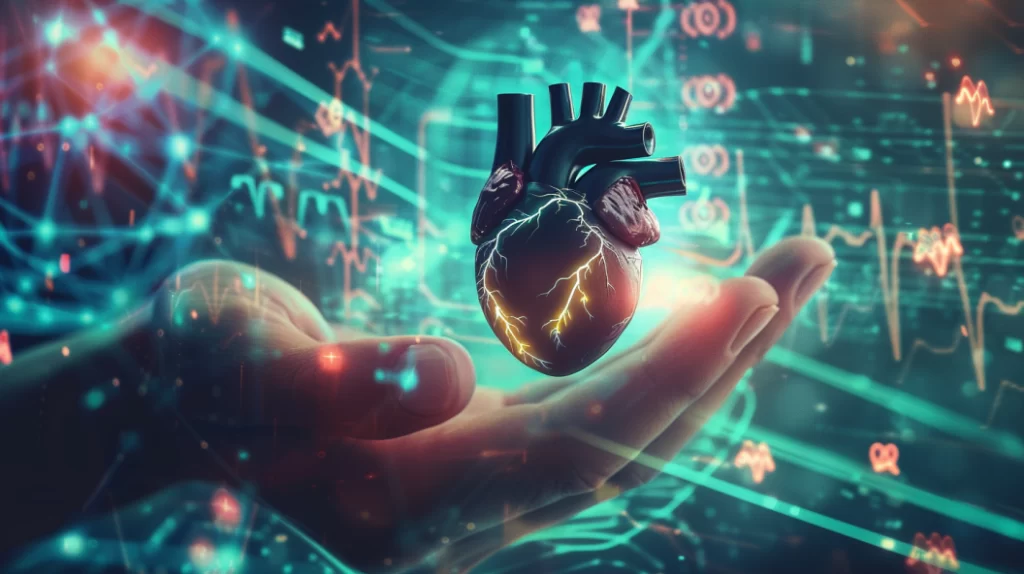Can Stun Guns Cause a Heart Attack?

People often use the terms Heart Attack and Cardiac Arrest interchangeably, but they’re not the same. A heart attack occurs when blood flow to the heart is blocked. Sudden cardiac arrest occurs when the heart malfunctions and suddenly stops beating. A heart attack is a “circulation” problem, and sudden cardiac arrest is an “electrical” problem. Discussing and knowing the difference is crucial to understanding how stun guns can affect the heart.
Around 60% of law enforcement agencies in the United States provide their officers with stun guns, highlighting the devices’ significance in modern policing. Concerns often arise about the safety of these high-voltage devices, particularly in terms of their potential to trigger cardiac arrest. It’s valid to question how stun guns, with their powerful shocks, could impact heart rhythms and potentially cause arrhythmias, particularly in individuals with existing heart conditions. While some see stun guns as a safer option, it’s crucial to consider the risks involved, especially for those with underlying heart issues. Understanding the science and controversies surrounding stun guns and their effects on cardiac health is vital for public safety and policy decisions.
Key Takeaways
- Stun guns can disrupt heart rhythm, potentially leading to serious arrhythmias or cardiac arrest.
- The risk of ventricular fibrillation is significant, which can cause cardiac arrest.
- Factors such as the location of the device’s barbs and the electrical waveform affect the heart’s stimulation.
- Elevated blood alcohol levels and structural heart disease increase the risk of adverse effects from stun gun shocks.
- Immediate CPR and defibrillation are vital for survival in cases of fibrillation induced by stun gun shocks.
Understanding Stun Guns
Stun guns are devices that deliver high-voltage shocks through direct contact, aiming to temporarily incapacitate an individual by applying electrical energy to the body. These weapons come in different models with varying shock characteristics and durations of incapacitation. They work by discharging high voltage to disrupt the body’s normal functions. Understanding the functioning of stun guns is essential for their safe and effective use. Knowing how these devices operate is crucial to avoid misuse or accidents. By using stun guns responsibly and following proper guidelines, individuals can enhance their personal safety in threatening situations.
When looking into the impact of stun guns, it’s crucial to consider how they can affect the heart. The heart is sensitive to electrical energy and can be stimulated by the shock from a stun gun or Taser. This stimulation is a major concern when it comes to discussing the safety and effects of these devices. Understanding how stun guns can influence the heart is essential for evaluating their potential risks and benefits. The electrical shock delivered by these devices can lead to cardiac stimulation, seriously affecting individuals on the receiving end. By looking into this aspect, we can better grasp the potential dangers and effects associated with stun guns, contributing to a more informed discussion on their use and regulation.
The risk of ventricular fibrillation (VF), a dangerous condition where the heart quivers instead of beating properly due to chaotic electrical signals, is a topic of great concern. While stun guns are primarily used to incapacitate individuals, factors such as the type of electrical pulse, and how deeply the current can penetrate the skin can all influence the risk of causing abnormal heart rhythms. Understanding these factors is crucial in assessing the potential for cardiac stimulation from stun guns. By considering the location of contact, their effects on the body, and the characteristics of the electric pulse, we can better comprehend the risks associated with using stun guns and their impact on heart health.
Stun guns operate by utilizing electrical energy and delivering a high voltage discharge, making it crucial for those worried about their effects on the heart to understand their functioning. It can be easier to grasp the potential risks involved by simplifying how they work. The impact of stun guns on the heart is a significant concern due to the electrical shock they produce. Therefore, it is essential to delve into the specifics of their operation and the potential dangers they pose. Providing detailed information about stun guns can help individuals make informed decisions about their use and safety precautions.
Heart Rhythm Disruption
When a stun gun delivers a high-voltage shock, it can disrupt the natural rhythm of your heart, which may lead to serious arrhythmias or even cardiac arrest. Many people are concerned about the safety of these devices and their potential impact on the heart. It’s important to understand the risks associated with stun gun use, especially regarding the heart’s function. The electrical shock from a stun gun can have severe consequences on the heart’s electrical activity, potentially causing dangerous irregularities. Therefore, knowing the potential dangers and risks of using stun guns is crucial to ensure safety and well-being.
| Condition | Description | Immediate Action |
| Ventricular Tachycardia | A rapid heart rhythm that can result from stun gun shock. | Monitoring & potentially medication. |
| Ventricular Fibrillation | A chaotic heart rhythm leading to halted blood flow. | Urgent CPR and defibrillation. |
| Sudden Cardiac Arrest | When the heart suddenly stops beating due to arrhythmias. | Immediate CPR and call for emergency help. |
| Arrhythmias | Disruptions in heart rhythms that can be serious. | Evaluation by a healthcare professional. |
| Blood Flow Halt | When heart rhythm disruptions stop blood flow to the body. | Emergency medical intervention. |
When someone is hit by a stun gun, it can affect the heart, which controls the body’s electricity. This can lead to serious heart issues like ventricular tachycardia or fibrillation. If this happens, it’s crucial to know that giving immediate CPR can help keep the blood flowing until medical help arrives. Being aware and ready in our community can make a difference and save lives.
Risk Factors
Before being exposed to a stun gun, it’s important to understand your risk factors. Knowing what makes you more vulnerable can help you navigate interactions safely, especially with law enforcement who decide if a stun gun should be used. Having high blood alcohol levels significantly increases the chances of experiencing negative effects from a stun gun shock. It’s not just about the immediate pain; it’s also about your heart’s health and the risk of ventricular fibrillation, a serious condition that could lead to cardiac arrest. Being aware of these risks is crucial to protect yourself from potential encounters involving stun guns.
Having structural heart disease puts your heart under even more strain. Using a stun gun can make things worse by adding stress to an already struggling heart. Understanding these risks, especially for law enforcement, is crucial to minimize harm to your heart. While doctors can’t control stun gun use, knowing these dangers can help you speak up for your safety in situations where stun guns might be used. It’s important to consider these factors to protect your heart health.
Case Studies and Evidence
When looking at risk factors, it’s important to consider how stun gun shocks can affect the heart. By examining case studies, we can better understand the link between stun guns and cardiac events. Many are interested in this topic due to concerns about heart health. It’s crucial to explore the impact of stun guns on the heart in a clear and straightforward manner.
Here’s what we’ve discovered together:
- Studies Show Potential Link: Research suggests a worrying connection between the shock from a stun gun and the onset of cardiac arrest. This isn’t just speculation; it’s supported by medical experts who’ve seen the effects firsthand.
- Autopsy Reviews Raise Concerns: Autopsies of individuals who’ve experienced sudden loss of consciousness after a stun gun shock reveal signs that point directly to ventricular fibrillation, a serious disruption of heart rhythm that can lead to death if not immediately treated.
- Role of Structural Heart Disease: The risk isn’t uniform; it escalates significantly if underlying structural heart disease exists. This condition can make the heart more susceptible to the electrical disruptions caused by stun guns.
- Immediate Monitoring: These findings underscored the importance of quick monitoring and resuscitation efforts post-stun gun exposure. While this step is essential, it’s evidence of how crucial immediate action is in preventing long-term damage or fatality due to cardiac events triggered by stun guns.
Immediate Response Measures
If someone experiences cardiac arrest after being shocked by a stun gun, it’s crucial to act quickly to prevent further harm. Start by closely monitoring their vital signs and level of consciousness. This attentiveness shows they have support and are not alone in this scary situation. Being alert and responsive can help assess the severity of the situation and provide necessary aid. Quick action and proper care can make a significant difference in their recovery. So, stay focused and ready to act as needed, ensuring the best possible outcome.
If someone is suspected of having a heart attack, it’s crucial to act fast and provide immediate help, such as CPR. This shows how important it is to support each other during emergencies. Getting medical help quickly is essential, as healthcare professionals are trained to provide necessary care in such situations. Remember, acting promptly can make a significant difference in saving a life.
When removing stun gun barbs or darts, it is crucial to have trained medical personnel handle the task. Mishandling this process could result in further complications. Medical professionals have the expertise needed to ensure timely and effective emergency interventions, reducing the risks associated with a stun gun-related cardiac event. It is important to entrust this task to those with the necessary training and knowledge to minimize potential harm.
Frequently Asked Questions
What Are the After Effects of a Stun Gun?
After a stun gun shock, you’re like a boat lost at sea—disoriented, weak, and confused. You might face muscle contractions, unconsciousness, or dizziness. It’s essential to seek medical help to navigate back to safety.
Can a Stun Gun Cause Permanent Damage?
Yes, a stun gun can cause permanent damage. It might disrupt your heart’s rhythm or harm the muscle, especially if you’ve got a pre-existing condition. Continuous shocks increase the risk of serious, lasting heart issues.
Is a Stun Gun Worse Than a Taser?
You’re not alone in wondering if stun guns are worse than tasers. Studies show that Tasers can be used from a distance and are potentially safer in urgent situations. However, the barbs can pierce deeply or unevenly and distribute current differently. Joining this conversation means you’re informed and cautious.
Are TASERS Life Threatening?
Yes, Tasers can be life-threatening. They risk causing cardiac arrest, not heart attacks, by disrupting heart rhythms. Using them carefully and monitoring anyone affected is crucial to prevent potentially fatal outcomes.

